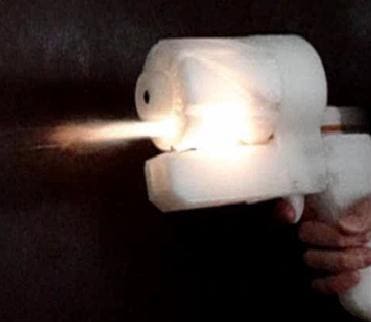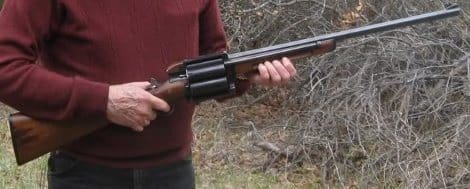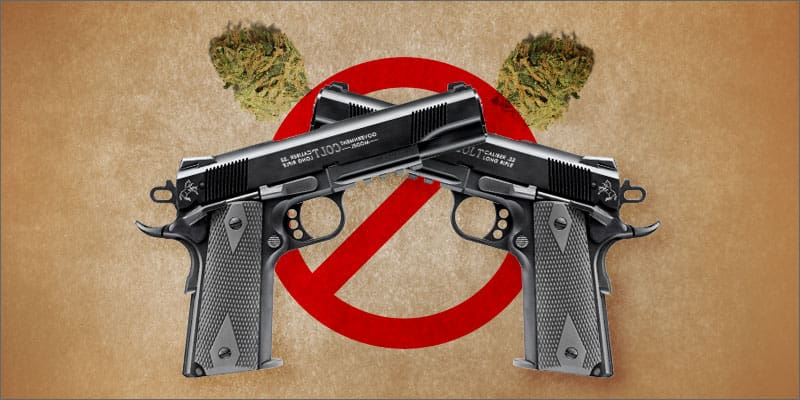This homemade revolving shotgun design seems well suited for a 3D printed/hybrid metal manufacture. While the version pictured uses cut off chambers from cast off 12 gauge barrels, the same effect could be accomplished by using sections of the appropriately sized water/gas pipe or tubing. The same tubing/pipe could be used for the barrel. The concept would be that the 3D printed parts would comprise the cylinder into which the chambers would be fitted and glued, and which would have the more difficult mechanical details to revolve the cylinder . . .
Perhaps a modification of the zig-zag revolver design by Yoshitomo Imura would work. A metal frame created with the “sandwich” system, laminated of sheet metal, would provide the necessary tensile strengh, which is not very high for smoothbore shotgun cartridges in any case. The top or bottom of the frame would consist of a bolt that would form the axis for the cylinder to rotate on. A loading/ejection port would be left on one side to load cartridges into the chambers. A simple rod or dowel could be used to eject them.

Surprisingly, revolving shotguns seem to have less problems with cylinder/barrel gas leakage than other systems, perhaps because of the relatively low chamber pressures for shotgun shells.One of the attractions of this sort of hybrid system is that it uses commonly available materials. Shotgun shells are the most easily available ammunition in most countries, and a revolver design does not rely on ammunition consistency to work well, as do semi-automatic designs. Even crude home made ammunition, such as Russians used to make with ground up match heads as gunpowder, would work in this type of system.
A six shot revolving shotgun cylinder whose bulk is composed of ABS plastic should not be too heavy or cumbersome. The steel chamber inserts would contain the bulk of the pressure created by firing the cartridge. The steel frame would prevent the chamber inserts from moving forward or backward when firing, provide the necessary tensile strength, and the attachment point for the barrel. A small welder could simplify frame construction, but is not necessary.
©2014 by Dean Weingarten: Permission to share is granted when this notice is included.





Ban tubing/pipe!
No need for a 3D printer on this project- a chopsaw and a welder will get that cylinder made in quick time, with no dependence on plastics to hold your gun together. Some bar stock, plate, and tubing are about all you need to make this bad boy.
I want one that revolves via lever.
Russian MTS-255. Afforadble state side version, please. And a mp412REX revolver to go with it.
Oh god. I want a 412 so bad. Frak the Strike One, give us the 412.
The MTS-255 costs thousands of dollars if I remember correctly (the fancy versions are around 15k). I too was hoping to one day make an affordable to shoot magnum revolver but I guess I will have to wait… or make a clone.
The MP-412 on the other hand makes me want to cry since I can’t have one. Only way to improve it would be to add an eight shot cylinder instead of the 6 shot one… and making a cylinder shroud so you can suppress it.
Sounds like a variation of street sweeper.
Or the Rossi Circuit Judge:
http://www.rossiusa.com/images/imagesMain/SCJT4510_011.jpg
http://www.rossiusa.com/product-list.cfm?category=15
Yes, except our peerless government put the Stryker or street sweeper on the NFA list.
Makes SO much sense too!
::Cough:: Saiga ::cough::
Thanks Dean- neat article- also clicked thru to Gun Watch and found the tip on Matt Brackens “Enemies” trilogy. Really enjoyed Castigo Bay, which I think I bought via a tip on TTAG.
You are welcome. I would rather have a Remington 870 or a Mossberg 500, but the purpose of these exercises is to educate about the possibilities.
I would bet that many, many Ukrainians would love to have a hybrid revolving shotgun about now.
If you want a gun in Ukraine, all you need to do is find the right bazaar. I did go to a gun store in Kiev once and they had some neat stuff, The problem was the permitting system keeps anyone but the wealthy and connected from becoming lawfully armed. So good people just go buy their guns illegally and hide them. Unjust laws are garbage.
I have a friend who spent considerable time in Ukraine. He talked to a number of people who said they were pacifists, and explained how much he valued having guns in the United States. After the current troubles started, one of the women told him that she had bought a gun. I presumed it was on the black (or should we say, free) market.
It’s not all that hard to buy a gun legally in Ukraine, actually. You don’t have to be “rich or well connected”.
A handgun, now, is another matter.
Same- 870 express synthetic 7 round, 18″ barrel. the one gun to do it all.
Matt Bracken’s trilogy seems almost prophetic in many ways.
Governments can ban all they want, but as long as men still have hands they will pound plow shares into sword blades.
… and those men will be shot by people who thought ahead.
Kidding. You’re absolutely right.
Good books. I read the trilogy over a weekend.
I recall reading that colt experimented with a revolving cylinder shotgun before the civil war but if think it was a cap and ball version. Then of course you have the even older Puckel gun with an added cylinder for square bullets for shooting the non Christian and one for round bullets for those saved in Christ …
True you can look it up.
I believe a muzzleloading version would be legal, even with a short barrel. I made a four-shot electrically fired, .45 caliber “pepperbox” muzzleloader 30 years ago. It only cost $12 and 12 hours of labor. I sent the article off to a magazine, who had said they would take it on “spec”. Unfortunately, they folded before they answered me, and I never got the photos or manuscript back.
Sooo illegal under NY State SAFE act.
Curious as to why it would be illegal under the “Safe” act?
Granted that I am not a lawyer….but all I have read for the past year, say the same as in wiki as follows:
Any revolving cylinder shotgun or any semi-automatic shotguns with one or more of the following:
Folding, telescoping or thumbhole stock
A second handgrip or a protruding grip that can be held by the non-trigger hand
Fixed magazine capacity of more than 7 rounds[18]
Ability to accept a detachable magazine.
https://en.wikipedia.org/wiki/Gun_laws_in_New_York
“Revolving cylinder”?
You can work around that, make a revolving square tube mag.
Well, I’m off to the shop, to fire up the mill and lath.
Leave out the S&W locking mechanism.
Webley-Fosberry.
And to think that just a year or so most of us were just amazed at a 3D magazine. In 10 years or so they will be cranking out M4s and m240 saws like it nobodies business. /sarc. (kinda)
Direct metal laser sintering (DMLS) guns are here.
http://blog.solidconcepts.com/evolution-custom-manufacturing/how-its-made-3d-printed-1911-pistol/
With time, the price will drop.
http://www.gunsamerica.com/blog/crye-precisions-six12-a-bullpup-revolving-shotgun-shot-show-2014/
(I’m not a ME or Materials guy, so) What happens with these printed guns when they heat up? Seems like it’s a really interesting set of first steps that are going on, but won’t there be a limit based upon the materials being used? What’s the logical “next step”?
I am a mechanical engineer and I work with gas turbines (HIGH temperatures). The properties of steels in general don’t begin to change until you approach what is called the “glass transition” temperature. Temps like this for steels are not seen in handguns. What might matter is what we call Low Cycle Fatigue (LCF) failure. This would manifest itself as a crack and lead to failure of the part. However, during part design, one allows for anticipated stresses plus a safety factor and usually designs for 1,000,000 cycles, so if there is a LCF failure, it it would be a surprise and probably due to some anomaly in the microstructure of a “normal” piece of steel. I’m not familiar with microstructure consistency in laser sintered metal parts.
Good Lord, and you conveyed it such that I think I understand it without seemingly dumbing it down! Thanks, this is good stuff!
Hmmm.
This might be a good application for a Nagant-type action, where the cylinder moves forward and closes the gap as the trigger is pulled.
A gas-sealing revolving shotgun! Excellent idea.
On the 1895 Nagant, the cylinder rotates & then jumps forward as the hammer reaches full cock. The cylinder face mates with the tapered edge of the breech.
You engineers out there?
Keep in mind that shotgun shells come in different lengths and unfold to their length after being fired. This means the forward movement has to be fairly significant and either is fixed for a shell length or has to be configurable.
I wasn’t envisioning having the lip of opened shell be part of the seal like the front edge of the brass is for a Nagant. Yes that could get insane with all the different sized shells out there.
Beyond that, there could be magnum cylinder models and 3 inch models, like we have today. Many shotties out there won’t take the longer loads. You are correct about having to allow for the shell to open, but that’s already true.
Gotcha – I was trying to envision how it would seal like the Nagant would. The Nagant, as I understand it, uses the cartridge brass to make the seal since it will expand to close the gap and then contract to allow the cylinder to return. I was kind of trying to envision how the shell itself could be part of that sealing process.
It is a very interesting idea. On a long arm, you could design a pump type mechanism to operate the Zig-Zag cylinder and a tapered steel wedge to move the whole cylinder forward to mate the chamber up against the back of the barrel. it probably is not necessary, but with 3D printing for the primary moving parts, It becomes fairly easy to implement. You could put a bit of a taper on the end of the chambers, and a receiving taper, like a forcing cone on the back of the barrel. Pulling the pump/actuator back would cock the striker, pull down the wedge and rotate the cylinder. pushing the pump/actuator forward would move the wedge up into place and move the cylinder forward. It goes a long way toward insuring that you have plenty of clearance for rotation and still have a pretty tight fit with minimal gap between the chambers and the barrel.
Still, it does add a bit of complexity.
I have thought of a continuous belt type system that would simply move the loaded champers in between the barrel and a breechblock. The links for the system could be printed. The system to move the chambers into place could be a open rotor rather like the old Dardick magazine fed system. It would have advantages because all of the parts would be smaller. It would also not be a “revolving cylinder” shotgun, to meet the NY unsafe act requirements.
You do not even need a belt for this design, just a hopper on one side and a container to receive the fired chambers on the other side. In use, when you have a lull, just reload the fired chambers and place them back in the hopper…
Another option would be to make a tube magazine to feed the spindle or rotor. That would make the whole configuration similar to a conventional pump shotgun. With 3D printing, complex parts become easy.
Comments are closed.